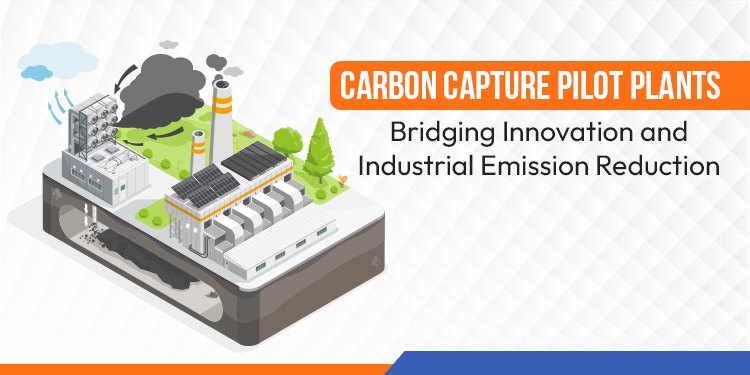Premier Pilot Plant People

Carbon Capture Pilot Plants: Bridging Innovation and Industrial Emission Reduction
Carbon Capture Pilot Plants: Bridging Innovation and Industrial Emission Reduction
What is Carbon Capture?
In simple terms, carbon capture refers to the process of trapping carbon dioxide (CO₂) emissions at their source, before they reach the atmosphere. For manufacturing, this is particularly critical. Heavy industries like cement, steel, chemicals, and energy production account for nearly 30% of global CO₂ emissions. Cement production alone releases roughly 0.9 tonnes of CO₂ per tonne of cement, underscoring the scale of the challenge. The carbon capture process includes three major steps:- Capture — Separating CO₂ from flue gases using chemical absorption, membranes, or adsorption.
- Transport — Moving compressed CO₂ via pipelines, road tankers, or ships to utilization or storage sites.
- Storage/Utilization — Injecting CO₂ deep underground (over 800 meters) in depleted oil and gas fields or saline aquifers, or converting it for use in other industries.
Benefits of Carbon Capture
The business case for carbon capture is increasingly compelling, especially as industries face stricter regulations and sustainability goals.- Regulatory Compliance: With more than 60 carbon pricing initiatives already implemented globally (World Bank, 2024), carbon capture helps manufacturers avoid high carbon taxes and meet emission reduction targets.
- Operational Sustainability: Capturing CO₂ at the source extends the viability of existing plants. According to the IEA, carbon capture could mitigate up to 6 billion tonnes of CO₂ annually by 2050, preserving industrial competitiveness.
- Economic Opportunities: Captured CO₂ can fetch commercial value — for instance, enhanced oil recovery (EOR) utilizes around 50 million tonnes of CO₂ each year, generating additional revenue streams.
- Corporate Responsibility: Brands integrating carbon capture strengthen their ESG (Environmental, Social, Governance) scores, attracting environmentally conscious investors and stakeholders.
- Market Readiness: Early adopters can benefit from emerging carbon credit markets, potentially earning $20–$50 per tonne of CO₂ captured.
Use of Carbon Capture in Industry
Manufacturers worldwide are leveraging carbon capture across various sectors:- Power Generation: Facilities like the Petra Nova project in Texas capture 1.4 million tonnes of CO₂ annually, equivalent to emissions from over 300,000 cars.
- Cement Production: Europe’s pioneering cement plants are trialing capture technologies to reduce their lifecycle emissions by nearly 40%.
- Steel Industry: Pilot projects have demonstrated CO₂ reductions of up to 60% during steel manufacturing processes.
- Hydrogen Production: ‘Blue hydrogen’ plants integrate carbon capture to produce low-emission hydrogen, capturing over 90% of process CO₂.
- Chemical Manufacturing: CO₂ from ammonia plants is captured and repurposed in urea fertilizer production, reducing process emissions by over 70%.
Carbon Capture Challenges
However, carbon capture is not without its challenges, especially in large-scale industrial environments:- High Capital Costs: On average, capturing one tonne of CO₂ costs between $40–$120, depending on the technology and scale.
- Energy Intensity: Capture processes can consume up to 20% of a plant’s energy output, necessitating efficiency optimization.
- Infrastructure Gaps: Adequate CO₂ pipelines and storage sites are still underdeveloped, particularly in emerging markets.
- Technological Complexity: Integrating carbon capture into existing operations requires precise engineering and robust safety protocols.
- Public Perception: Concerns around long-term storage safety call for transparent monitoring and regulation.
Carbon Capture Requirements
For successful deployment, certain foundational elements must be in place:- Process Customization: No two manufacturing processes are identical. Capture systems must be tailored to specific emission streams, flow rates, and impurity levels.
- Reliable Infrastructure: Efficient capture and safe transport demand high-integrity pipelines and compression systems designed for supercritical CO₂.
- Robust Monitoring: Post-injection monitoring for leakage and well integrity ensures long-term storage compliance.
- Cost Management: Innovations in solvent regeneration and heat integration can reduce operational costs by up to 30%, making projects more financially viable.
- Scalable Testing: Pilot plants play a pivotal role in testing new configurations before full-scale rollout.
How Pilot Plants Help the Manufacturing Industry Embrace Carbon Capture
Pilot plants are the bridge between concept and commercial-scale carbon capture. They offer manufacturers a controlled, scalable environment to test, optimize, and validate technologies before major investment. Here’s how they make the difference:- Risk Reduction: Pilot plants allow early identification of design flaws, process inefficiencies, and integration issues before full deployment.
- Data-Driven Decisions: They provide critical operational data, flow rates, capture efficiency, energy consumption, and maintenance requirements, ensuring accurate scaling.
- Customization: Manufacturers can simulate their specific production conditions, including flue gas compositions, temperature ranges, and pressure scenarios.
- Technology Validation: Pilot plants validate new capture materials like advanced amine solvents or solid sorbents, ensuring they perform reliably under real-world conditions.
- Cost Optimization: Insights gained from pilot runs help reduce full-scale costs by refining process design, utility consumption, and equipment sizing.
XytelIndia: Your Partner in Building the Future of Clean Manufacturing
At XytelIndia, we understand the urgency and complexity of industrial decarbonization. With decades of expertise in designing and delivering fully integrated pilot plants, we confidently empower manufacturers to explore carbon capture technologies. Our solutions are tailored to your industrial reality, from concept development to process optimization and pilot plant commissioning. Our commitment is simple: we help you test thoroughly, optimize smartly, and scale sustainably. Together, we can transform challenges into opportunities and pave the way for a cleaner, more competitive future for manufacturing.Get in Touch
You will be amazed as how partnering with us becomes a game changer in your quest for R&D glory.

 Call Us
Call Us